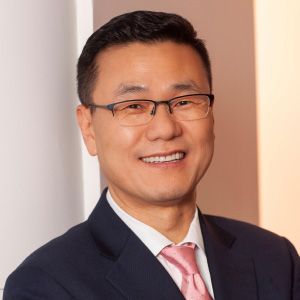How we can make retirement plans better
I was born in South Korea, in a family structure where multiple generations lived in one household, tending—usually—to their farm. The cultural expectation was that the first-born son would take over the farm and household when the parents retired. So, although we moved to the United States when I was eight years old, and I have five older sisters, this cultural expectation held firm. When my parents could no longer work, their retirement plan was me.

When my parents retired well into their 70s, they didn’t have a retirement account of any kind. Because my parents were 43 years older than me, I had to support them almost as soon as I started my career in my 20s. That’s a big challenge and a ton of pressure for a 20-something.
I had a front-row seat to the challenge of retiring without financial security, and the immense pressure this puts on the retiree and their families—and it’s more than just the dollars and cents.
After 30 years in financial services, my career has largely been about helping others build wealth. More recently, I’ve narrowed that focus to helping people save and invest for their retirement goals. My personal and family story now align with my professional career, giving me a purpose I can personally appreciate and fully dedicate myself to. I want to help make retirement plans better, so that a 25-year old in the future won’t have to support a three-generation household.
The retirement plan industry has an incredibly important mission to accomplish—helping people retire with the money they need to live with dignity. And it’s not an easy one. Employee inertia, poor financial knowledge, and a fear that money in a plan is locked in and can’t be touched until retirement are all barriers to enrolling and saving. To break down these barriers, I see three equally important jobs that can help us achieve that mission: getting people in a plan, helping them save enough, and helping them stay on track to and through retirement.
Job 1: getting people in and aware of their plan
We have a lot of tools we can use to help people save. ERISA allows for a wide range of plan design options, and the government expanded its focus on retirement with the SECURE Act and SECURE 2.0. And with digital media and personalization being boosted by developments in AI, we have more powerful tools than ever to help us engage and educate participants.
Unleash the power of auto
Automatic features—auto-enroll, auto-increase, and auto sweep—have proven to be effective at overcoming inertia to get people saving. We’ve found that plans using both auto-enrollment and auto-increase have 25% more participants on track for 70% income replacement in retirement.1 That helps to explain why SECURE 2.0 is making it mandatory for new 401(k) and 403(b) plans starting at the end of this year.
Engage and educate
It’s not enough to just get people in a plan. We also need to engage and educate them. At John Hancock, we found that participants who engage with their plan have a 20% higher average contribution rate than those who aren’t.2 Using personalized nudges, tools, and education along the way to retirement, we’re helping people improve their financial knowledge and well-being so they’re better prepared when they get to the retirement income stage.
Job 2: helping people save enough
Retirement plan participants look to their employers, financial professionals, and retirement plan providers for help with their financial decision-making.2 Sponsors generally have good intentions when they design their plans. But participants can easily take default and match rates as signals of the amount they should be saving—although that’s not the intention of these rates.
Check the signals you’re sending
There are plenty of differing opinions in the industry about how much of their wages people need to contribute. But I think most agree that 3%—and even 6%—employee contribution rates aren’t enough. Yet that’s the unintended signal that many plans are sending.
Default rates—More than 8 in 10 plan sponsors say they want to encourage higher contribution rates.3 But more than half have set an auto-enrollment default contribution rate of 3% or less, and more than 9 in 10 have a default of 6% or less.4 Sponsors often decide on a lower rate out of concern that a higher rate would cause more opt outs. But historically, we’ve found plans with higher default contribution rates actually have fewer opt outs than plans with lower default contributions.5
Match formulas—Most 401(k) plans also offer a matching contribution to encourage savings. Less than 6 in 10, however, require a participant to contribute more than 6% to get the full match.5 Even when the employer and employee contribution are combined, that’s likely not enough for most participants. But few employers have big enough pockets to substantially increase their actual match.
Employers that want to send the right signal without a negative hit to their budget could consider a stretch match. For example, a plan with a match 100% of up to a 4% contribution could send a more realistic signal with a 50% of 8% match—without increasing the employer contribution.
Job 3: keeping people on track to and through retirement
Three-quarters of sponsors allow loans from their plans,5 recognizing that lack of access to cash could keep employees from enrolling. Several provisions of SECURE 2.0 also leaned in on access to cash, such as opening up penalty-free withdrawals to certain participants and allowing others to self-certify for hardships.
But allowing access to plan savings could be sending a confusing signal. Putting guardrails in the plan can help safeguard against excess leakage to help participants stay on track.
Use plan design to allow access and minimize leakage
Of course, we need to help participants understand the risks of taking from their retirement savings with education and tools. Thoughtful plan design can also help. Plan sponsors can consider limiting the number of loans allowed, to help signal that they should be a rare source of relief, rather than a revolving door. And allowing loan continuance to terminated participants can help reduce defaults and enable people to replenish their account, in spite of their urgent need for cash.
My family role has become my career rallying cry
Because of my heritage, I was my parents’ retirement plan, a role I was fortunate to be able to play. But it gave me a unique feel for what happens when there’s no plan, and no savings.
I consider the mission we have in the retirement plan business to be a noble purpose. To achieve it, we'll need to use every tool in our toolbox to help people help themselves—including auto features, personalized engagement, clear signals, and guardrails to keep them on track. So that, regardless of heritage or family situation, when the time comes, Americans can retire with actual cash in their plan for their financial future.
1 State of the participant 2022 report, John Hancock, 2022. 2 In November 2022, John Hancock commissioned our ninth annual stress, finances, and well-being survey with the respected research firm Edelman Public Relations Worldwide Canada Inc. (Edelman). An online survey of 3,825 workers was conducted between 11/29/22 and 12/14/22 to learn more about individual stress levels, their causes and effects, and strategies for relief. John Hancock and Edelman are not affiliated, and neither is responsible for the liabilities of the other. 3 “Hot topics in retirement and financial well-being,” AON, 2023. 4 “Plan sponsor 2023 defined contribution survey,” PLANSPONSOR, 2023. 5 State of the participant 2021 report, John Hancock, 2021.
Important disclosures
Important disclosures
The content of this document is for general information only and is believed to be accurate and reliable as of the posting date, but may be subject to change. It is not intended to provide investment, tax, plan design, or legal advice (unless otherwise indicated). Please consult your own independent advisor as to any investment, tax, or legal statements made.
INTENDED FOR PLAN SPONSOR AUDIENCE.



